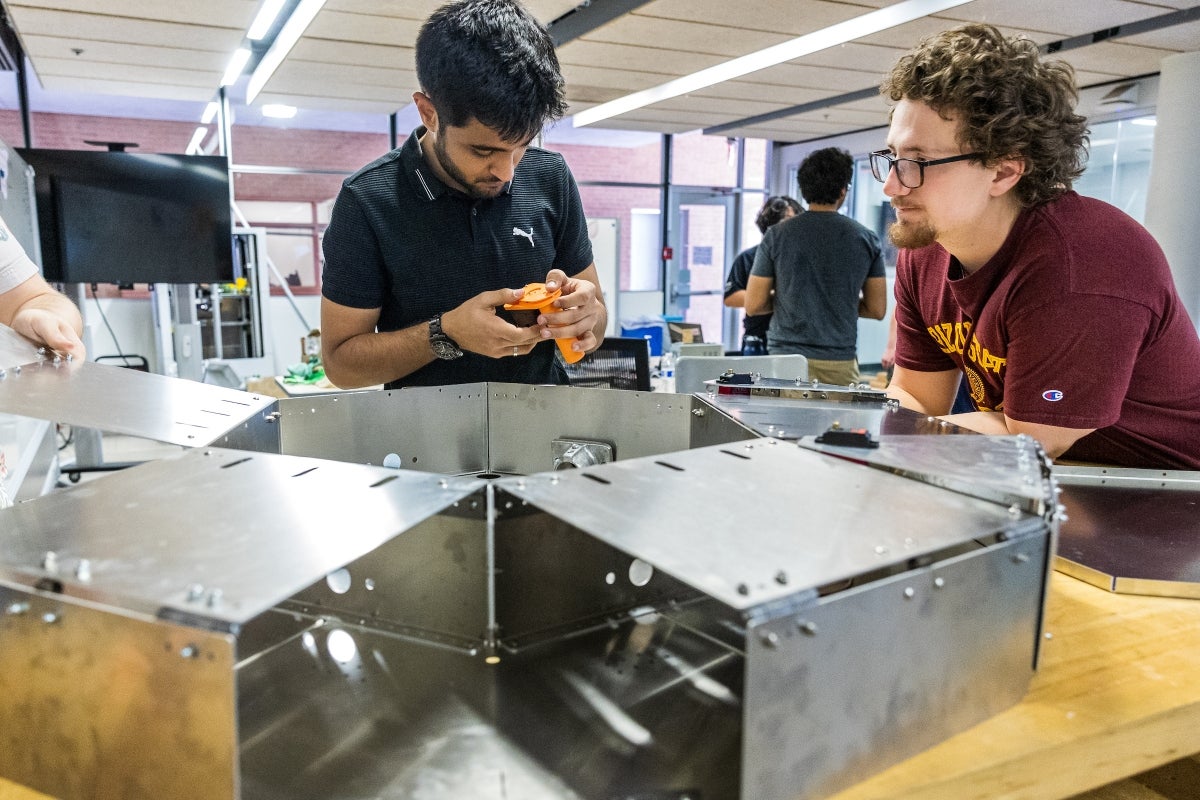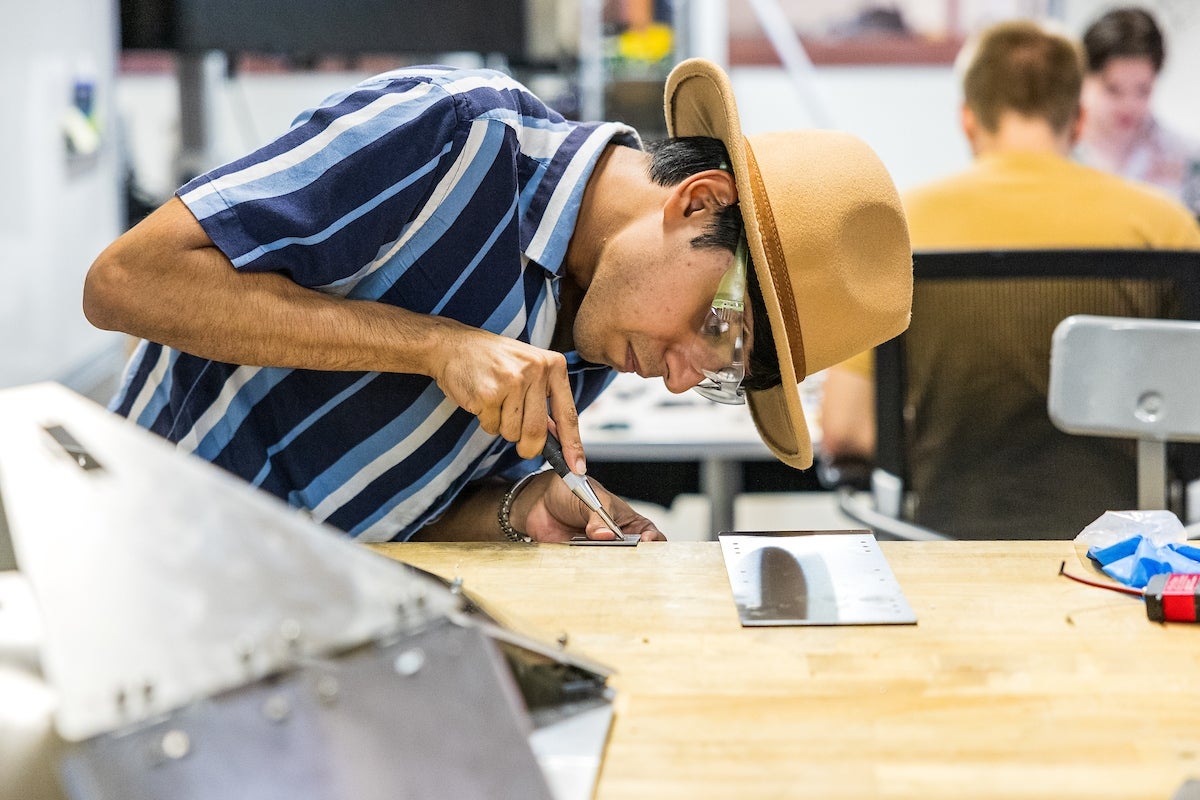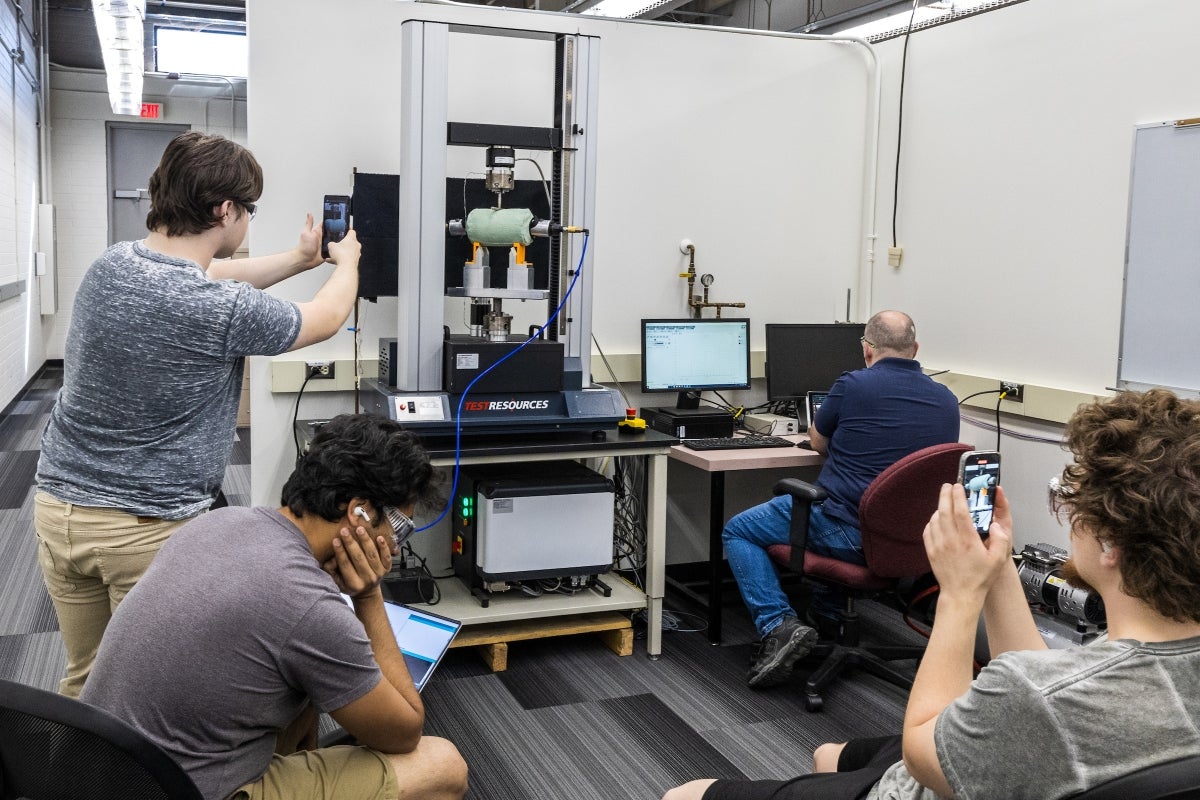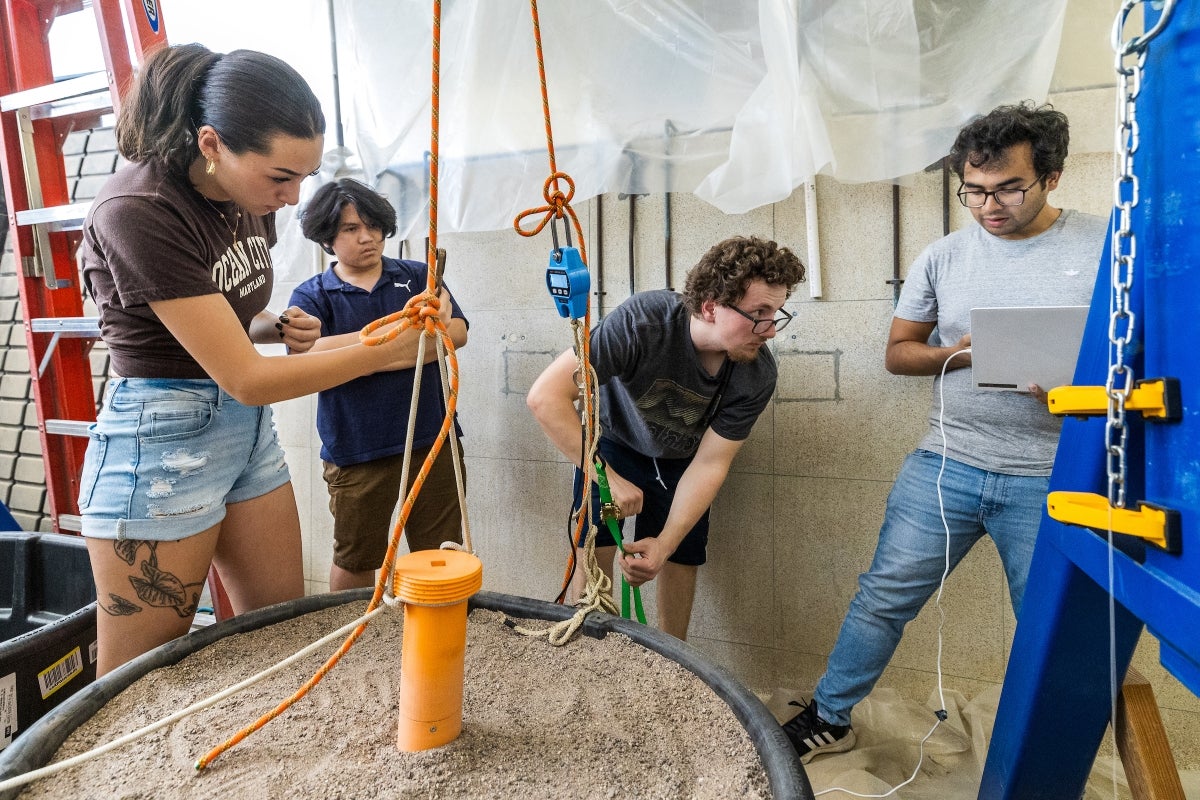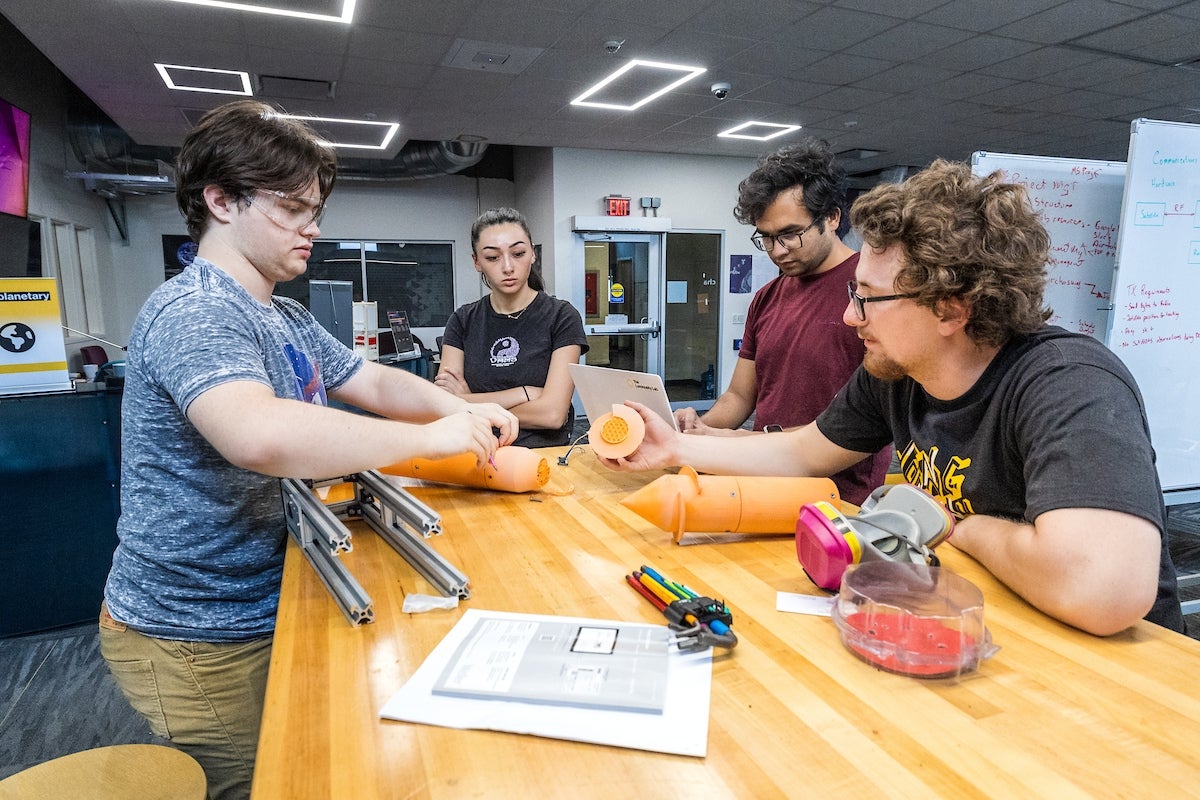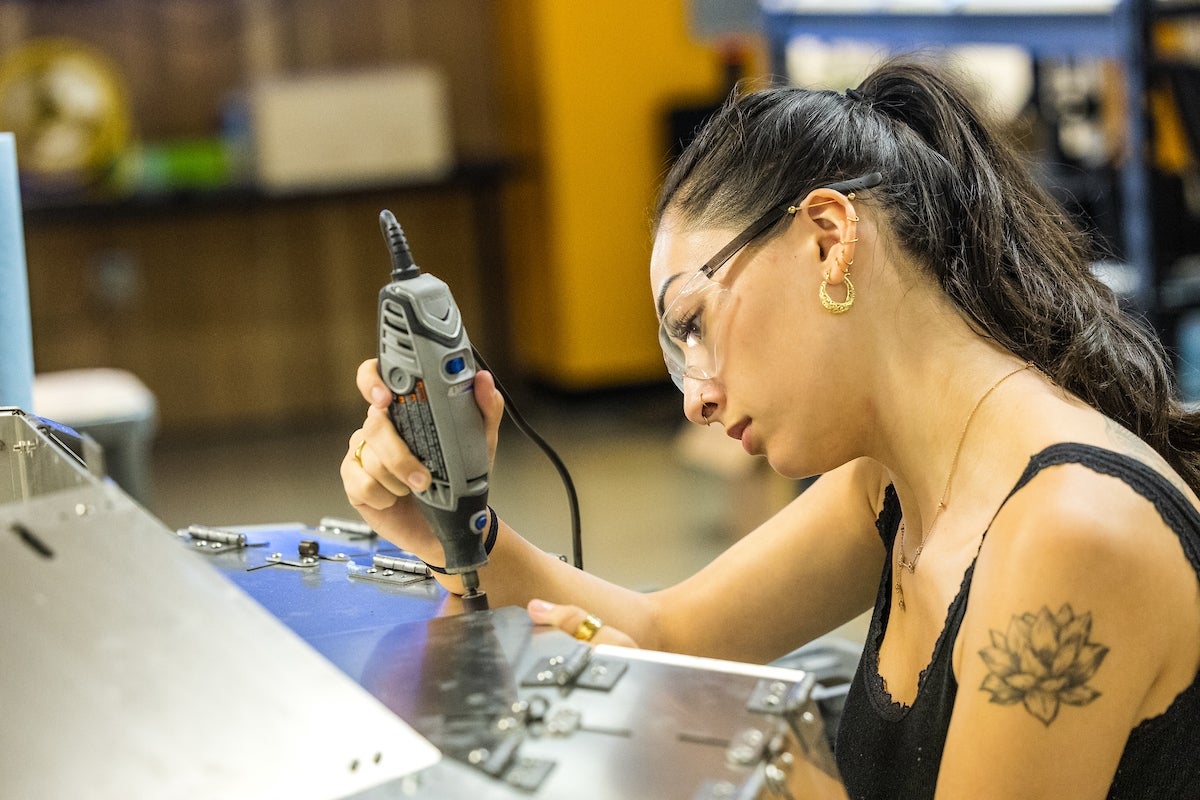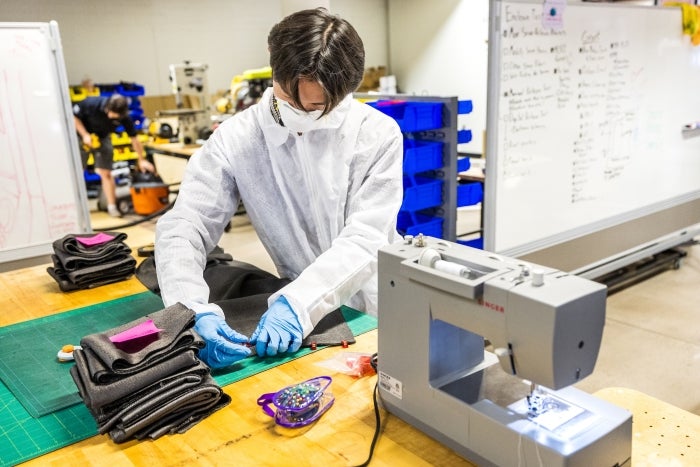Rocket science: Students land opportunity to create inflatable lunar pad for NASA

Electrical engineering graduate student Sarwan Shah (back left), fourth-year mechanical engineering student Grant Lesley (back right), second-year mechanical engineering student Connor Owens (front left), mechanical engineering graduate student Vaibhav Khanna (center) and senior director of ASU's Luminosity Lab Tyler Smith set up a 1/5 scale model of the AEGIS inflatable lunar landing pad at SP Crater in the San Francisco Volcanic Field, just 25 miles north of Flagstaff, Arizona, on Oct. 14. The landing pad was developed by a team of students at ASU’s Luminosity Lab for NASA’s BIG Idea Challenge, a rigorous competition for students to design, build and test prototypes related to NASA’s current mission needs. Photo by Samantha Chow/Arizona State University
Editor's note: The ASU AEGIS team won the Best Systems Engineering award — one of two awards given to the six teams that presented at the Las Vegas forum held Nov. 11–12.
This story is featured in the 2024 year in review.
Sixteen Arizona State University students have landed an opportunity to participate in the 2024 Breakthrough, Innovative and Game-changing (BIG) Idea Challenge.
The NASA-sponsored competition allows students to design, build and test projects for real-life NASA missions while also preparing them for successful aerospace careers.
“It's an amazing experience for the students who participate,” said Tyler Smith, senior director of ASU’s Luminosity Lab. “They have the opportunity to work on a real project to advance the technology-readiness level of a concept and further NASA's mission to return to the moon.”
Students from participating universities were tasked by NASA with building an inflatable system that would address a lunar challenge. A lightweight and compressible structure requires less space and lowers the cost involved in sending missions to deep-space destinations.
The ASU team competed against colleges and universities across the country and was one of only six finalists awarded up to $150,000 for their winning concept and proposal.
ASU’s BIG idea?
The AEGIS — Inflatable Lunar Landing Pad System, which will enable rockets to safely and successfully land on the moon.
The final student teams will attend a forum in Las Vegas Nov. 11–12 to present their final prototypes, which will be judged based on their technology readiness.
“This is NASA's largest student-funded grant competition, so it's very, very competitive and prestigious,” Smith said. “The teams in this competition are often from the most prestigious space engineering institutions, like MIT and Caltech.”
This year marks the third time students from ASU’s Luminosity Lab are participating in the BIG Idea Challenge, having won each previous year. With that in mind, the odds look good for them in Las Vegas.
“We are batting 1,000,” said Smith, who believes they might lock up the top honor — the NASA Artemis Award — this year.
The award is given to the team whose concept has the best potential to contribute to and be integrated into a future Artemis mission, said Janice Miller, project lead and communications manager at the National Institute of Aerospace.
So far, the students have been building and testing each component of the design, a process that began in ASU’s Interplanetary Initiative Lab, where students tested a 3D-created anchor system that needs to lift a 600-pound container filled with sand.
The anchor is necessary to secure the landing pad in place on the surface of the moon.
While the first test failed, subsequent tests have been successful.
“There is still a lot of work to do,” said Connor Owens, a second-year mechanical engineering student at ASU’s Ira A. Fulton Schools of Engineering. He is helping to design and build the inflatable system.
Planning for the unexpected
There’s plenty to think about when landing a rocket on the moon. And a lot of inherent problems.
For one thing, the design has to accommodate for factors that happen in a completely foreign atmosphere under conditions that may or may not be known or understood.
For example, unlike the Earth, the moon doesn’t have winds that can erode rock and create smooth stones. Instead, its surface is covered with “lunar regolith” — sharp rocks and debris that are created by meteorite impacts and produce a fine, powdery dust.
When a rocket descends on the moon, the velocity of the sharp shards of glass regolith can scatter like brush in an Arizona dust storm and ruin both the multimillion-dollar rockets and the moon mission. It can also damage potential future habitats or settlements on the lunar surface.
That’s the problem the ASU team took on.
“By the time you actually get close to the surface of the moon, you're blowing up so much of what is essentially moon dust that you're landing blind,” said Elizabeth Arnold, who participated in the 2022 challenge and is now a student advisor for the team. “You can't see the ground anymore. So by making a landing pad that has a rim at a certain angle, we can redirect all of the thrust.”
Arnold said one of the biggest challenges of the inflatable landing pad system is handling the high temperatures from the lander propulsion systems during landing, which can reach as high as 3,000 degrees Celsius (5,432 Fahrenheit).
“The extremely high temperatures can damage the inflatable structures and electronics in the landing pad,” said Arnold, a graduate of the Ira A. Fulton Schools of Engineering who secured internships at NASA’s Jet Propulsion Lab and Honeybee Robotics after participating in the BIG Idea Challenge.
Many of the participants were drawn from the Luminosity Lab, an interdisciplinary research lab driven by a group of high-performing students.
The team is made up of students from the Fulton Schools, the School of Sustainability and the School of Mathematical and Statistical Sciences, as well as students studying industrial design, graphic design and fashion at the Herberger Institute for Design and the Arts.
“A lot of them hadn’t worked in anything space-related prior to the competition,” Arnold said.
Tokiya Aono, a fashion studies major, was the designer and seamstress responsible for prototyping and sewing the tarp for the pad.
“As a fashion student, being a part of this project is a bit bizarre but exciting,” he said.
“When I joined, I had almost zero knowledge about space exploration and hardly had interest in the subject. ... But once I worked with the team, I got into it a bit more," Aono said. "Although I had a hard time almost every day trying to figure out words that I have never heard of, I can say that I am having fun with this project.”
Ask for the moon
Securing up to $150,000 from NASA was not easy. Once the students identified the challenge, they had to create and design a solution that they detailed in a 27-page proposal. It contained plans to design, build and test their system, as well as a budget to do so. Their project is judged at many junctures throughout the process.
“They got to ideate on real challenges that NASA is facing today, and then will have NASA actually use their ideas when they are developing systems and trying to solve those problems,” said Arnold, a graduate student at The Fulton Schools.
The process of creating something as complex as a lunar landing pad is akin to any creative process.
“You try and you try and you try,” said Owen, a mechanical engineering major who helped design the launching pad.
Over the summer, Owen spent eight hours each day watching videos and reading to figure out how to approach the problem. A go-to resource was the "Lunar Sourcebook: A User’s Guide to the Moon," a comprehensive reference of all of the scientific and technical information on the moon.
“It’s a lot more complicated than you think, and even if you figure it out, no one tells you how to do it on the moon,” said Owens, a former Vanderploeg Luminosity Scholarship Program winner. “So you have to imagine how that would work. This is high-level civil engineering.”
The end product will be an auto inflatable and reusable landing platform designed to be transported by a rover to a designated landing zone. The landing pad will have a radar system to track incoming rockets, or “landers,” and an antenna for transmitting its relative position to the lander. It will fit in a hexagonal container and weigh about 330 pounds.
In October, the ASU team performed field-testing at the Flagstaff SP crater lava flow and rocket hot fire testing in Mohave, California.
Grant Lesley is the project lead for the challenge.
“It’s a hard problem,” said the fourth-year mechanical engineering major from The Fulton Schools.
“There is a lot of energy going into this project. While we are doing the testing, we have to make all of the necessary assumptions to ensure that the results of our testing are applicable to the moon."
But the experience has been very rewarding for Lesley.
“Working for NASA has opened up so many doors in my mind as well as opportunities,” he said. “And it is getting me a lot of kudos at parties and reunions.”
Real-world experience
Miller said that it is common for students to conclude the competition and have an internship or even a job simply because of the opportunities presented through the BIG Idea Challenge.
“We have had stories of folks participating where part or all of their technology has been commended and recognized as a high potential for integration in space exploration,” she said.
Kevin Kempton, a program element manager in NASA’s Game Changing Development program has been a BIG Idea Challenge panel member for many years.
“The real value to NASA is the insight gained from the building and testing of these innovative concepts,” he said. “Data and lessons learned from these efforts is very valuable when deciding what technology is feasible and should be developed further. Another important benefit for NASA is helping the next generation gain the key skills needed to develop space systems.”
ASU’s Jim Bell, an advisor for the team, has been actively involved with several NASA solar system exploration missions.
“Working as a team on this kind of NASA engineering challenge activity represents an amazing opportunity for our students to interact and network with government and industry space science and engineering experts from around the country,” said Bell, a professor in the School of Earth and Space Exploration. “The Luminosity Lab’s AEGIS team is a spectacular example of the kinds of talented, collaborative and innovative student teams that we foster here at ASU.”
More Science and technology

4 ASU researchers named senior members of the National Academy of Inventors
The National Academy of Inventors recently named four Arizona State University researchers as senior members to the prestigious organization.Professor Qiang Chen and associate professors Matthew…

Transforming Arizona’s highways for a smoother drive
Imagine you’re driving down a smooth stretch of road. Your tires have firm traction. There are no potholes you need to swerve to avoid. Your suspension feels responsive. You’re relaxed and focused on…

The Sun Devil who revolutionized kitty litter
If you have a cat, there’s a good chance you’re benefiting from the work of an Arizona State University alumna. In honor of Women's History Month, we're sharing her story.A pioneering chemist…


